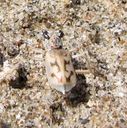Ellipsed-winged Tiger Beetles
Ellipsoptera
Classification
- Phylum: Arthropoda
- Subphylum: Hexapoda
- Class: Insecta
- Order: Coleoptera
- Suborder: Adephaga
- Family: Carabidae
- Subfamily: Cicindelinae
- Tribe: Cicindelini
- Genus: Ellipsoptera
Pronunciation
How to pronounce Ellipsoptera: //ˌɛlɪpˈsɒptɪrə//
These audio files are automatically generated. While they are not always 100% accurate, they are a good starting point.
Images






Summary
The Puritan tiger beetle (Ellipsoptera puritana) is a flashy tiger beetle found in sandy and rocky habitats along the eastern U.S. It is endangered, primarily due to habitat loss and competition with other species.
Physical Characteristics
Medium-sized beetle, reaching up to 0.56 inches; long black legs; wings range from bronze-brown to green; metallic blue underside with small, white hairs; distinct cream-white pattern outlining the margins of wing covers; bulging eyes; thinner and sleeker than other tiger beetles.
Identification Tips
Look for the distinctive cream-white pattern along the margins of the wing covers and the bulging eyes to identify the Puritan tiger beetle.
Habitat
Found in sand beaches, rocky cliffs, and terrestrial wetlands including rivers, streams, and creeks. Prefers sandy beaches backed by cliffs along the Chesapeake Bay in Maryland, and black sandy beaches in Connecticut and Massachusetts.
Distribution
Located in Massachusetts (Hampshire County), Connecticut (Middlesex County), and Maryland (Calvert and Cecil-Kent counties). Populations are separated by over 600 miles of land.
Diet
Preys on amphipods, beach arthropods, flies, lice, fleas, ants, and small invertebrates.
Life Cycle
The Puritan tiger beetle has a two-year life cycle. Adults emerge mid-to-late July, lay eggs by mid-August, and all adults die by the end of August. Larvae hatch by early September and create burrows, feeding for 22 months before pupating.
Reproduction
Females travel to cliffs to lay eggs after mating, and typically produce one viable offspring in the wild, but up to 100 when raised in captivity.
Conservation Status
Endangered; listed as threatened under the Endangered Species Act; last review in 2019 indicates a high degree of threat, but low recovery potential.
Ecosystem Role
Invertivorous, preying on small invertebrates and scavenging on dead organisms.
Evolution
Formerly a subgenus of Cicindela, established as a genus by Dokhtouroff in 1883 with 14 species, all mostly in the US, especially in the south.
Tags
- Ellipsoptera
- Puritan tiger beetle
- Coleoptera
- Conservation
- Endangered species